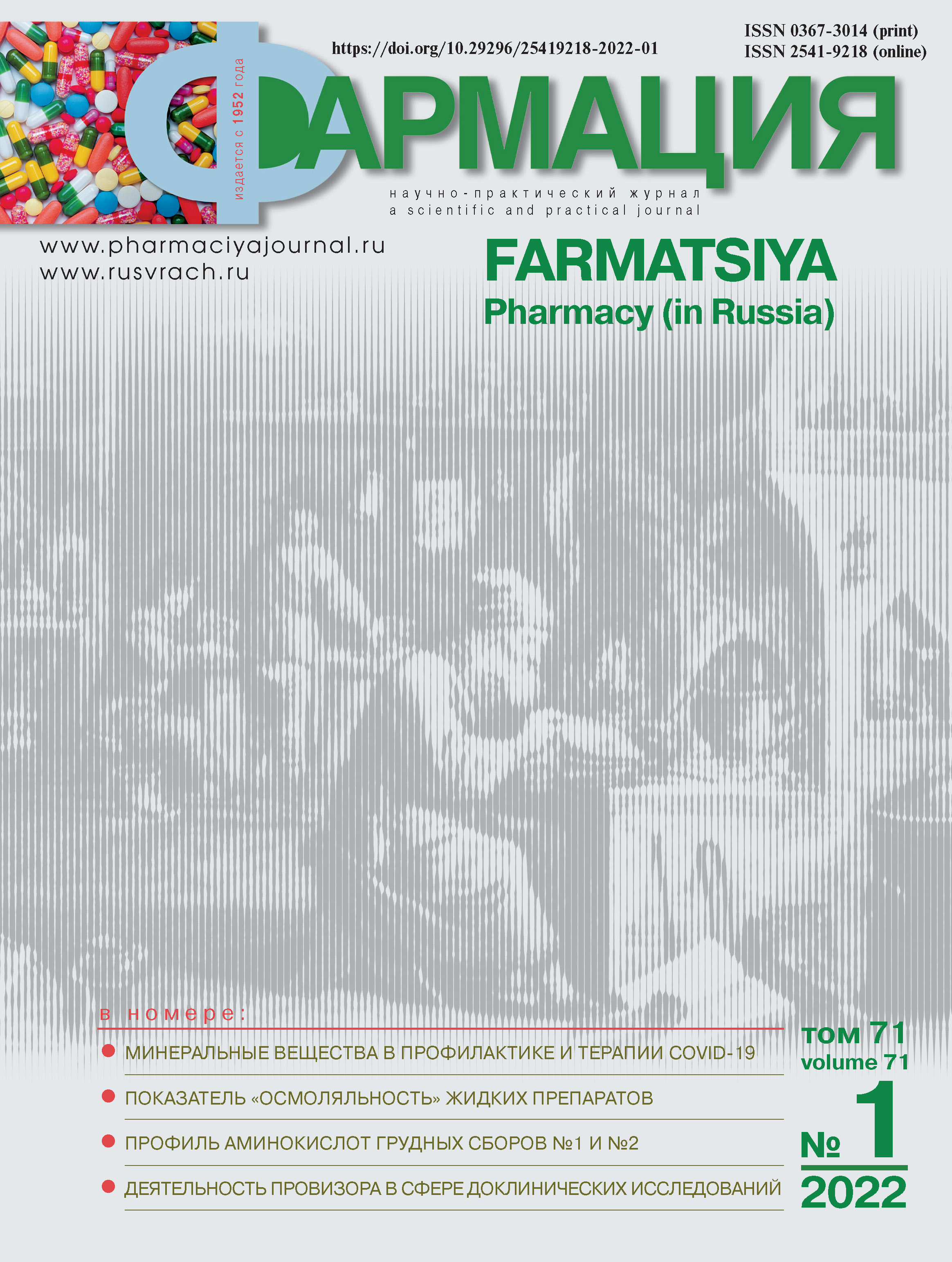Amino acid profile of Pectorales species No.1 and No.2 and infusions based on them
- Authors: Chevidaev V.V.1, Kakhramanova S.D.1,2, Bokov D.O.1,3, Rylina E.V.3, Samylina I.A.1, Bessonov V.V.3
-
Affiliations:
- Sechenov First Moscow State Medical University (Sechenov University)
- Federal State Budgetary Institution Scientific Center for Expertise of Medicinal Products
- Federal State Budgetary Scientific Institution «Federal Research Center of Nutrition and Biotechnology»
- Issue: Vol 71, No 1 (2022)
- Pages: 33-38
- Section: Articles
- URL: https://journals.eco-vector.com/0367-3014/article/view/113619
- DOI: https://doi.org/10.29296/25419218-2022-01-05
- ID: 113619
Cite item
Abstract
Full Text
About the authors
Vladimir Viktorovich Chevidaev
Sechenov First Moscow State Medical University (Sechenov University)
Email: vovchev@rambler.ru
PhD student in pharmaceutical sciences of Pharmaceutical Natural Sciences Department Russian Federation,
Sabina Dzheykhunovna Kakhramanova
Sechenov First Moscow State Medical University (Sechenov University); Federal State Budgetary Institution Scientific Center for Expertise of Medicinal Products
Email: 9096268511@mail.ru
PhD student in pharmaceutical sciences of the Pharmaceutical Natural Sciences Department Russian Federation,
Dmitry Olegovich Bokov
Sechenov First Moscow State Medical University (Sechenov University); Federal State Budgetary Scientific Institution «Federal Research Center of Nutrition and Biotechnology»
Email: bokov_d_o@staff.sechenov.ru
PhD in pharmaceutical sciences, associate professor of the Pharmaceutical Natural Sciences Department; researcher of laboratory of chemistry of food products Russian Federation,
Elena Valerievna Rylina
Federal State Budgetary Scientific Institution «Federal Research Center of Nutrition and Biotechnology»
Email: hellch@mail.ru
PhD in pharmaceutical sciences, researcher of the laboratory of metabolic and proteomic analysis Russian Federation,
Irina Alexandrovna Samylina
Sechenov First Moscow State Medical University (Sechenov University)
Email: samylina_i_a@staff.sechenov.ru
doctor of pharmaceutical sciences, corresponding member of the RAS, professor of the Pharmaceutical Natural Sciences Department Russian Federation,
Vladimir Vladimirovich Bessonov
Federal State Budgetary Scientific Institution «Federal Research Center of Nutrition and Biotechnology»
Author for correspondence.
Email: bessonov@ion.ru
Doctor of Biological Sciences, head of the laboratory of chemistry of food products Russian Federation,
References
- Rai V.K. Role of amino acids in plant responses to stresses. Biologia plantarum. 2002; 45 (4): 481-7.
- Белоусов М.В., Фурса Н.С. Изучение аминокислотного состава ряски малой (Lemna minor L.). Бюллетень сибирской медицины. 2011; 5. https://doi.org/10.1016/j.scienta.2019.108635
- Добрина Ю.В., Мальцева А.А., Сорокина А.А., Сливкин А.И. Аминокислотный состав листьев и плодов лимонника китайского, произрастающего в Воронежской области. Фармация. 2016; 63 (6): 16-20.
- Шилова И.В., Кувачева Н.В., Самылина И.А. Аминокислотный состав альфредии поникшей. Фармация. 2016; 63 (4): 35-8.
- Чистякова А.С., Гудкова А.А., Сорокина А.А. Аминокислотный состав горцев ряда Amphibiae Kom. Фармация. 2020; 69 (6): 31-7. https://doi.org/10.29296/25419218-2020-06-06
- Доровских Е.А., Ермакова В.А., Ковалева Т.Ю. Изучение аминокислотного состава ноотропного сбора. Фармация. 2020; 69 (3): 18-22. https://doi.org/10.29296/25419218-2020-03-03
- Недилько Ольга Викторовна, Яницкая Алефтина Владимировна Изучение аминокислотного состава надземной и подземной частей солодки голой. Химия растительного сырья. 2020; 1. https://doi.org/10.14258/jcprm.2020014678
- Озимина И.И., Фролова О.О. Целенаправленный поиск биологически активных веществ в растениях. Современные проблемы науки и образования. [Электронный ресурс]. Режим доступа: https://science-education.ru/ru/article/view?id=8334
- Qureshi M. N., Stecher G., Bonn G. K. Quality control of herbs: determination of amino acids in Althaea officinalis, Matricaria chamomilla and Taraxacum officinale. Pak. J. Pharm. Sci. 2014; 27 (3): 459-62.
- Хусейнов У. М. Изучение биохимического состава экстрактов из растений подорожника большого (Plantago major L.) и мяты перечной (Menthapiperita L.). Известия Академии наук Республики Таджикистан. Отделение биологических и медицинских наук. 2017; 1: 46-50.
- Stoyanova M.A., Perifanova-Nemska M.N. Biologically active compounds from Tussilago farfara L. IOP Conference Series: Materials Science and Engineering. - IOP Publishing, 2021; 1031 (1): 012103. https://doi.org/10.1088/1757-899X/1031/1/012103
- Государственная фармакопея Российской Федерации XIV изд. [Электронное издание]. Режим доступа: http://femb.ru/femb/pharmacopea.php
- Государственный реестр лекарственный средств. Режим доступа: https://grls.rosminzdrav.ru/
Supplementary files






